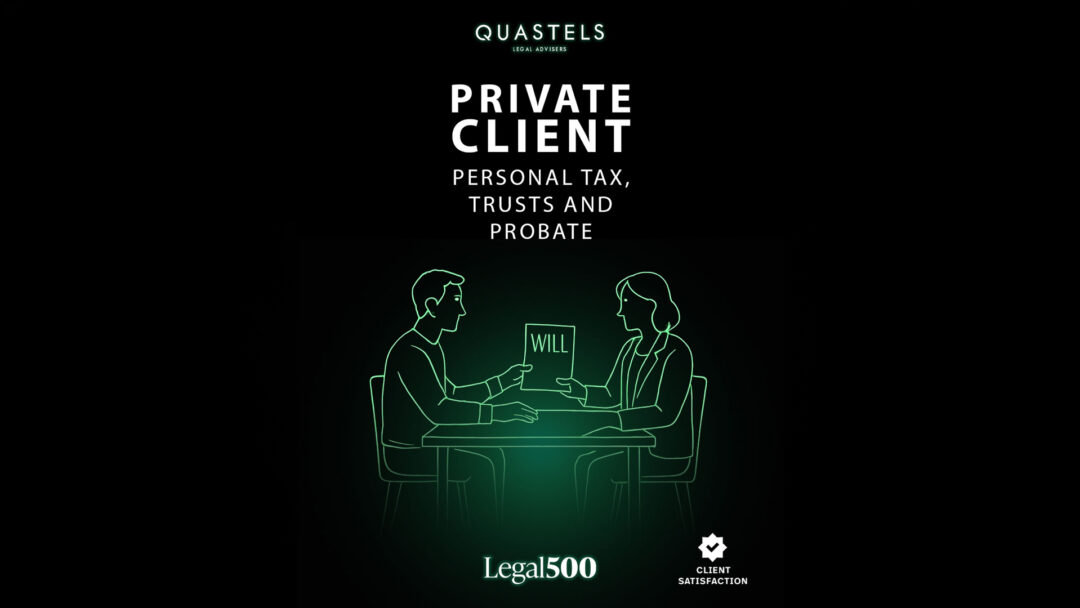Latest Posts

Quastels Recognised in the Legal 500 UK 2026 Rankings
We are pleased to announce that Quastels has been recognised in this year’s The Legal 500 UK 2026 rankings across four categories:
- ‘Leading Firm’ in Commercial Property: Corporate Occupiers
- ‘Leading Firm’ in Private Client: Personal Tax, Trusts and Probate
- ‘Leading Firm’ in Industry Focus: Hospitality & Leisure
- ‘Firm to Watch’ in Industry Focus: Retail & Consumer
We are pleased to have retained our ‘client satisfaction’ badge, which reflects our dedication to exceptional service and expertise across the firm.
About The Legal 500
The Legal 500 is widely regarded as one of the most respected legal directories, evaluating law firms and individual lawyers through rigorous independent research, client testimonials, and industry insight. Earning a place in The Legal 500 reflects a firm’s commitment to delivering exceptional legal services and cultivating strong client relationships.
At Quastels, we are proud of our longstanding reputation for excellence and client care, and we are delighted to be recognised in this year’s rankings.
Key Rankings

Commercial Property: Corporate Occupiers
For five consecutive years, our Commercial Property team has been recognised in the Commercial Property: Corporate Occupiers category.
The ranking highlights our extensive legal expertise, particularly in:
- Portfolio management
- Acquisitions
- Disposals
Our practice spans the retail, leisure, and office sectors, delivering bespoke advice to businesses navigating commercial property matters.
Recognised Legal Professionals
The Legal 500 ranking specifically commends our department heads and key individuals for their contributions:
- Mark Cornelius (Partner and Co-Head)
- Naomi Jones (Partner and Co-Head)
- Jonathan Gross (Partner)
- Aisha Anjum (Senior Associate)
Client Testimonials
The following testimonials have been collated independently by the Legal 500 research team.
“Quite frankly, it’s the team’s proactive nature, the partners are available when you need to speak to them, and they are always trying to provide a solution for you and the underlying client.”
“The team have a deep understanding of our business and tailor their advice accordingly; we know we can rely on them to be concise and responsive to our complex and changing needs.”
“Quastels have gone above and beyond acting on our behalf. The due diligence checks have been extensive, and they utilised relationships with firms abroad to ensure that the recorded notice was served promptly and at a reasonable cost to us as the client.”

Private Client: Personal Tax, Trusts, and Probate
Our Private Wealth team has been recognised for the first time in The Legal 500, in the Private Client: Personal Tax, Trusts, and Probate category.
The ranking highlights our expertise in existing and emerging fields, including:
- Tax
- Trusts
- Succession Planning
- Tax aspects of cryptoassets
Recognised Legal Professionals
The Legal 500 specifically mentions the work and expertise of:
- Ben Rosen (Partner and Head of Department)
- Jack Burroughs (Senior Associate)
Client Testimonials
The following testimonials have been collated independently by the Legal 500 research team.
“This is a team which is high energy, extremely responsive and authentic.”
“Ben Rosen is a delight. He absolutely loves what he does which makes him really fun to work with. He inspires great confidence with clients and has the sort of grasp of complex material to be able to articulate it clearly.”
“Ben Rosen – excellent solicitor. Prepared to go the extra mile for a client. Highly recommended.”

Industry Focus: Hospitality & Leisure
This year, we are pleased to further expand our presence in The Legal 500 rankings, being named a ‘Leading Firm’ in the Industry Focus: Hospitality & Leisure category.
Our Hospitality & Leisure sector offering received recognition for assisting clients across the restaurant, theatre, hotel and pub sectors, amongst others, with key work including:
- Sales
- Restructurings
- Commercial contracts
- Fund structuring
- Asset management
Recognised Legal Professionals
The Legal 500 recognised these key players in our Hospitality & Leisure group:
Client Testimonials
The following testimonials have been collated independently by the Legal 500 research team.
“We have used Quastels numerous times and they can always find a commercial solution to sometimes complex problems, not just looking at the legal ramifications but the commercial ones as well.”
“One of the standout features of Quastels is the diversity within their team – not just in background, but in experience and perspective. This diversity enhances their ability to handle complex, cross-disciplinary issues with nuance and agility.”
“I’m especially grateful to Adam Convisser for his time, expertise, and unwavering support. In moments of stress, he reassured me and guided me through challenges with professionalism, empathy, and clarity. I’ve developed a genuinely strong relationship with him, which speaks volumes about the quality of service and personal attention Quastels provides.”

Industry Focus: Retail & Consumer
We are pleased to have retained our standing as a ‘Firm to Watch’ in the Industry Focus: Retail & Consumer category. Our Brands & Luxury sector offering received recognition for its cross-disciplinary approach, providing legal solutions across corporate, commercial, real estate, employment, and governance issues.
Recognised Legal Professionals
The Legal 500 highlighted the contributions of:
Thank You
We are incredibly proud to be growing our recognition in The Legal 500, which reflects the development of the firm over the past twelve months. A heartfelt thank you to our clients, colleagues and The Legal 500 for their continued support and kind words. Our growing recognition motivates us to continue delivering fantastic service across all of our practice and sector areas.
If you require legal assistance, please contact us, we would be delighted to help.
Read More
Gifting Intellectual Property in a Will
Whether Intellectual Property (IP) rights make up a major or minor share of the value of an estate, testators should carefully consider how they are gifted under their Will. It is essential to ensure that IP is properly identified, valued and transferred to beneficiaries on death.
What is Intellectual Property?
IP refers to many different types of legal rights and intangible assets. Some of the most common rights to consider in estate planning are:
- Copyrights – rights to original artistic, dramatic, musical and literary works lasting for 70 years after the death of the author/creator
- Patents – protection for inventions and innovative processes lasting for 20 years from registration
- Trademarks – distinguishing branding features that can be registered for a ten year period and renewed thereafter
- Design rights – protection for the appearance of a product, in whole or in part
These types of IP often generate income during the testator’s lifetime and after their death, typically through royalties and licensing, so should be considered in the process of drafting or updating a Will.
Key considerations when gifting IP in a Will
Identification
Any IP assets should be clearly identified in the Will or accompanying Letter of Wishes with details such as registration information, creation dates and any associated agreements (such as licensing arrangement) noted in the relevant document.
Any ambiguity could lead to disputes or delays in probate being granted and onward transfer to beneficiaries.
Asset management and choice of executor
IP rights often require ongoing management including renewing registrations, negotiating terms of licensing and dealing with any infringement issues. This should be considered when dealing how IP assets are passed down beneficiaries.
Some testators will choose to create a trust structure to administer the ongoing management of these assets. In certain circumstances this can help to preserve the value of the assets over time, but advice should be sought to determine if this is a suitable solution.
It is common to appoint specialist executors or trustees to manage these assets. This is a particularly important consideration when the testator’s IP generates significant income or is involved in complex commercial agreements.
Tax implications
IP assets are subject to Inheritance Tax so accurate valuation on death is fundamental. Valuation of these assets can be complex, particularly where multiple income streams are involved, so professional valuation may be required. It is also likely that there will be income tax considerations for beneficiaries and executors. Tax advice should be sought if necessary.
Conclusion
In summary, where a testator holds IP rights they should carefully consider how they would like to pass these assets to their beneficiaries. Proper identification and valuation of these assets is essential to ensuring that the administration of their estate can progress smoothly and without delay.
Obtaining tax and estate planning advice helps to ensure that these assets are protected and preserved when being passed down to beneficiaries.
To discuss the contents of this article, please contact our Private Wealth & Tax team via the form below.
Read More
Deemed Ownership in SDLT: Lessons from the Angela Rayner Case
A Political Storm Over Property Tax
Deputy Prime Minister Angela Rayner has found herself at the centre of a tax controversy involving the underpayment of Stamp Duty Land Tax (SDLT).
The issue arose after she purchased a flat in Hove in May 2025, paying standard SDLT rates on the £800,000 transaction. However, it later emerged that she had previously transferred her share of the family home, which she purchased in April 2016 with her then-husband Mark, into a trust for their disabled son. Under complex deeming provisions in SDLT legislation, Rayner is treated as still owning that property for SDLT purposes, thereby triggering the 5% surcharge applied to second homes or additional properties.
Though the trust had been established by court order and she had said that she had relied on professional advice from “a conveyancer and two experts in trust law”, Rayner ultimately admitted under-paying stamp duty by £40,000, referred herself to the independent ethics adviser and began discussions with HMRC about settling the shortfall. It is worth adding that the conveyancing firm had since denied that they gave additional SDLT advice and relied on Rayner’s instructions to compute the SDLT due. Now, with confirmation that she breached the ministerial code and her resignation confirmed, her political career appears to be in tatters.
Her case illustrates how technical tax provisions can entrap even high-profile public figures and highlights the importance of understanding deemed ownership rules under Schedule 4ZA of the Finance Act 2003.
Deemed Interests Under Schedule 4ZA of the Finance Act 2003
The additional SDLT surcharge on second homes is governed by Schedule 4ZA of the Finance Act 2003. Under paragraph 8, individuals may be deemed to hold a “major interest” in residential property even when they do not hold legal title personally.
Specifically:
“A person is treated as having a major interest in a dwelling if it is held in trust for a child (under 18) of the person, or of the person’s spouse or civil partner.”
In practical terms, this means that if a parent places a property into a trust for their minor child, even if done by court order, they may still be treated as owning it when calculating SDLT on future purchases. This can inadvertently trigger the 5% surcharge for owning multiple properties.
This provision aims to prevent tax avoidance through indirect ownership structures. However, it also catches entirely legitimate trust arrangements, including those established for the care of vulnerable or disabled minors.
Trusts for Vulnerable People: No SDLT Exemption
There is a common misconception that trusts for disabled beneficiaries enjoy broad tax exemptions. While Capital Gains Tax and Inheritance Tax rules provide favourable treatment for vulnerable beneficiary trusts, SDLT does not follow suit. HMRC’s SDLT Manual makes it clear that:
- A parent is deemed to have an interest in property held in trust for their minor child, regardless of disability.
- This applies whether or not the parent is a trustee.
- Court-ordered trusts do not override the deeming rules.
The Rayner Example
Angela Rayner purchased a property in Hove in May 2025 and paid standard SDLT, having transferred her prior home into a trust for her disabled son. However, under paragraph 8, she was deemed to still have an interest in that first property, meaning the higher SDLT rate should have applied.
Although Rayner notes she had relied upon professional advice from “a conveyancer and two experts in trust law”, HMRC’s position is clear: deemed ownership applies regardless of intent or legal title, and ignorance of the rule is no defence.
The Risk of Inadvertent Non-Compliance
Rayner’s case is not unique. Many individuals overlook these deeming provisions, particularly when trusts are set up for personal or protective reasons rather than for tax planning.
Key risks include:
- Unwitting underpayment of SDLT when purchasing a new property.
- Exposure to interest and penalties from HMRC (up to 30% in careless cases).
- Reputational damage, particularly for individuals in public office or regulated professions.
Even more critically, individuals acting as trustees, whether appointed by court or voluntarily, have a legal duty to be aware of the nature and effect of the trust agreement. Trustees are expected to understand their legal obligations, the structure of the trust, and the property held within it. This fiduciary responsibility extends beyond the administration of the trust itself and includes awareness of any tax implications that may arise when the trustee acts in a personal capacity, such as when purchasing property. Where a trustee fails to disclose a trust interest that could affect SDLT treatment, they may be deemed negligent, even if acting in good faith.
This highlights a broader issue which is that conveyancers can only act on what they are told. A buyer who omits material information, such as a role in a trust that holds residential property, risks incorrect SDLT treatment and exposure to penalties, regardless of their interest.
Conclusion
The Angela Rayner case has brought public attention to a corner of tax law that can have substantial consequences. The SDLT deeming rules are not concerned with fairness or intent; they apply automatically and without exemption. Legal and tax professionals advising on family trusts, particularly involving minors or disabled beneficiaries, must have a working knowledge of these provisions, and importantly, trustees, especially as the buyer of a residential property, must be aware of the need to disclose any interest (direct or deemed) in other properties, including trust-held ones to their conveyancers.
As the Rayner case shows, the cost of oversight is not just financial, but reputational.
Read More